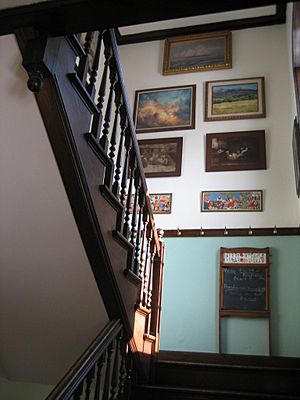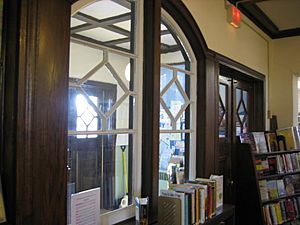Oregon Public Library facts for kids
Quick facts for kids |
|
|
Oregon Public Library
|
|
|
U.S. Historic district
Contributing property |
|

The Oregon Public Library in January 2007.
|
|
| Location | 300 Jefferson St., Oregon, Illinois |
|---|---|
| Built | 1909 |
| Architect | Pond and Pond |
| Architectural style | Arts & Crafts, Classical Revival |
| Part of | Oregon Commercial Historic District (ID06000713) |
| MPS | MPL015 - Illinois Carnegie Libraries Multiple Property Submission |
| NRHP reference No. | 03000352 |
| Added to NRHP | May 9, 2003 |
The Oregon Public Library is a special building in Oregon, Illinois. This town is the main city of Ogle County. The library building was finished in 1909. Before that, the library books were kept in different places. None of those places were made to be a library.
A very rich man named Andrew Carnegie gave money to build this library. He was a philanthropist, which means he used his wealth to help others. The people of Oregon voted to change their library from a city library to a "township" library. This change made it possible to get Carnegie's money. The building was ready in 1908, but the library officially opened in 1909.
The library was designed by architects Pond and Pond from Chicago. They were part of an art group called the Eagle's Nest Art Colony. This group influenced their design. The library mixes two styles: Classical Revival and the Arts and Crafts movement. The building even has an art gallery on its second floor. Artists from the Eagle's Nest Colony gave their art to start a permanent collection there. This collection has 64 paintings and sculptures. It also has a collection of Currier and Ives pictures. These pictures are worth a lot of money, about US$700,000!
The Oregon Public Library is very important. It was added to the U.S. National Register of Historic Places in 2003. This means it's a special historic site. Later, in 2006, it became part of a larger historic district that also got this special recognition.
Contents
History of the Library
The idea for a library in Oregon started long before the current building. The first Oregon library began in 1872. But it didn't have its own home. At first, library books were kept in a drug store. Then they moved to the County Treasurer's office. Later, the library rented office space in a bank building. This continued until 1905. That's when the people of Oregon decided to make a big change.
In 1905, citizens had to choose. Should the library stay a city library? Or should it become a "township" library? They voted in a special election called a referendum. Becoming a township library had a big benefit. It meant the library could get money from Andrew Carnegie.
Carnegie first offered US$7,000 for a new library. After the voters approved the change, he increased the grant to $10,000. To get the money, the library had to be a township library. Also, a building site had to be chosen. A spot at the corner of Jefferson and Third Streets in Oregon was picked.
The Library's Art Gallery
Eagle's Nest Art Influence

Even before the library was built, artists wanted it to have an art gallery. Members of the Eagle's Nest Art Colony pushed for a second-story gallery. This art colony was started in 1898 by sculptor Lorado Taft. It was located on the bluffs overlooking Oregon, near the Rock River.
Later, Andrew Carnegie's secretary, James Bertram, made strict rules for Carnegie libraries. He didn't want them to be used for many different things. He also had to approve all library plans. But the Oregon library was built before these rules came out. That's why it was able to include the art gallery.
The Eagle's Nest Art Colony was made up of artists from Chicago. They were from the Art Institute of Chicago or the University of Chicago. They came to Ogle County to escape the hot Chicago summers. Two of the first members of the colony were the architects Allen and Irving Kane Pond. They were the ones who designed the Oregon Public Library. Their connection to the art colony led them to create this special library.
The building was finished after the Carnegie grant was approved. Its first use was in October 1908. A colony member, Leon A. Malkielski, held an exhibition of 100 paintings there. The library itself started lending books in 1909. The art colony often held art shows and lectures. The new library building became a place for these events. Hamlin Garland, a writer who won a Pulitzer Prize in 1921, even spoke at the Oregon library. He was a member of the Eagle's Nest Colony.
Amazing Art Collections
The art gallery on the library's second floor officially opened on July 4, 1918. This date marked the start of the library's permanent art collection. Artists from the Eagle's Nest Colony gave many pieces. They donated twelve statues, twenty oil paintings, and four portraits.
One famous statue is a 4-foot (1.2-meter) plaster model of The Eternal Indian. This was made by Lorado Taft in 1908. He was preparing to create the large Black Hawk Statue. This statue is located at the original site of the Eagle's Nest Colony. In total, the permanent collection has 32 paintings and 32 sculptures by Eagle's Nest artists.
A local citizen also gave the library a Currier and Ives collection. It has 46 Currier and Ives lithographs. It also includes 14 lithographs by Nathaniel Currier. These two collections are very valuable. They are worth over $700,000!
Besides these historic artworks, the library also has art by local artists. One Oregon resident often donates art from the annual Grand Detour Art Show. Other local people have also given their artwork. The library has about 30 modern pieces by artists from the area.
Library Architecture

The Oregon Public Library's design shows styles from the late 1800s and early 1900s. It has parts of Classical Revival architecture. But its unique, playful style is very much like the Arts and Crafts movement. The Chicago firm of Pond and Pond designed the building. It is made of light-colored brick. Red bricks are used for trim and details, which stand out against the light brick. The library has two stories and a full brick basement. It has about 5,500 square feet (511 square meters) of space.
Even though it uses some Classical architecture ideas, it's not a purely Classical building. Its rooflines, main entrance, and window placement are not perfectly balanced. This asymmetrical look is a key feature of the Arts and Crafts style. The building has simple shapes and not much fancy decoration. This also links it closely to the Arts and Crafts movement. You can see this influence most clearly inside the building.
The Arts and Crafts movement is more of a design idea than a strict style. But it has typical features. These include dark, heavy wood and simple decorations. The Oregon Public Library has many of these features. Dark wood is used throughout the building. You can see it in the stairwell to the gallery. It's also in the balusters (stair railings) and newel posts (main posts of the railing). The four-panel wooden interior doors also show this style. The ceilings have coffers (sunken panels) and exposed wooden beams. Inside, there's also a large wooden floor clock from 1909. There's a built-in storage cabinet and two wooden fuse boxes. All these items show the Arts and Crafts movement.
The building does have some Classical Revival elements. But they are few and mostly around the front entrance. Below the front entrance hood, there are two stone pilasters (flat columns). There's also a stone lintel (a beam above a doorway). Relief work decorates the pediment (the triangular part above the entrance). Seven concrete stairs lead up to the front door. The whole front entry looks like a temple. On the library's east side, there are stone-capped buttresses (supports). These parts show the Classical Revival style.
Why the Library is Important
The Oregon Public Library was added to the U.S. National Register of Historic Places on May 9, 2003. It was recognized for its special architecture and its importance for education. The building is a great example of the Arts and Crafts movement. As a Carnegie library, it met the rules for being listed on the National Register. These rules are part of the Illinois Carnegie Libraries Multiple Property Submission.
In 2006, the Oregon Commercial Historic District was also listed on the National Register. The Oregon Library was included as a "contributing property" in this district. This means it's an important part of the historic area. The library building is considered the most "outstanding" Arts and Crafts building in the whole historic district.
See also
 In Spanish: Biblioteca Pública de Oregón para niños
In Spanish: Biblioteca Pública de Oregón para niños




